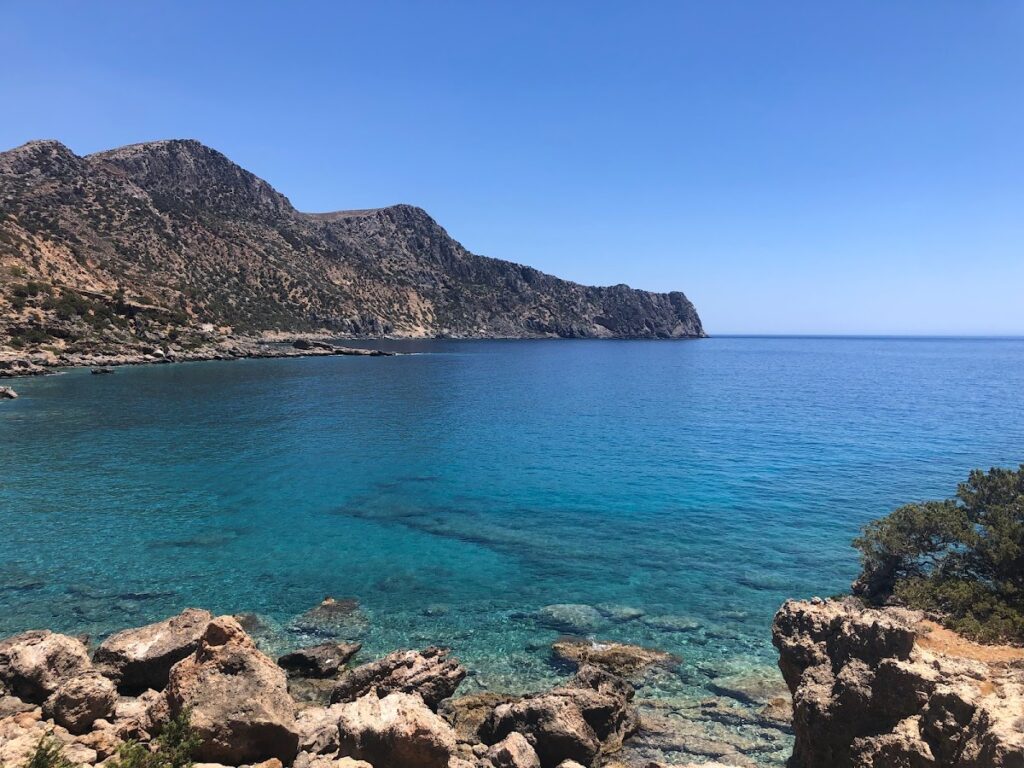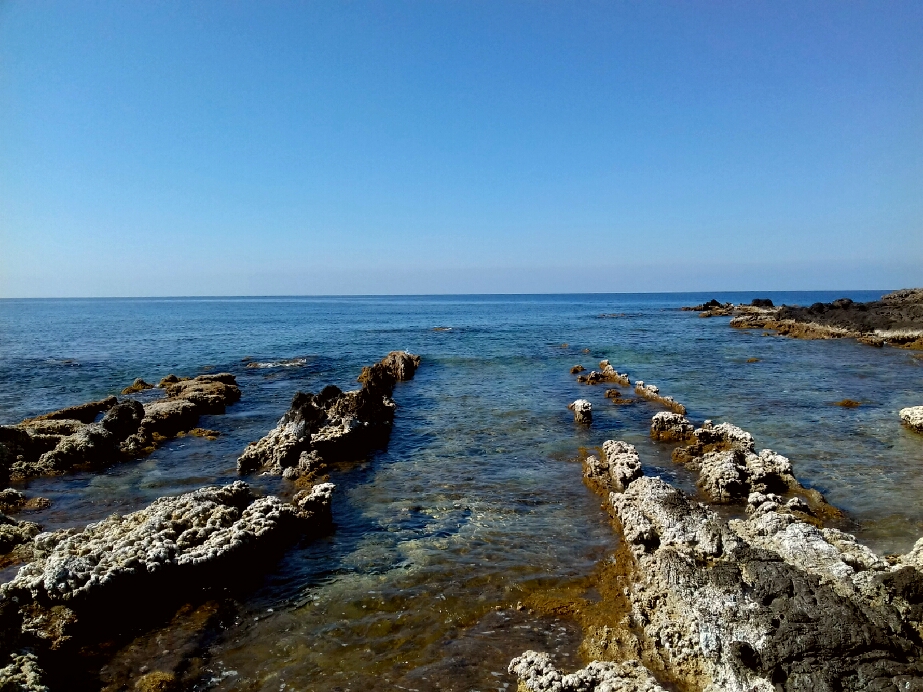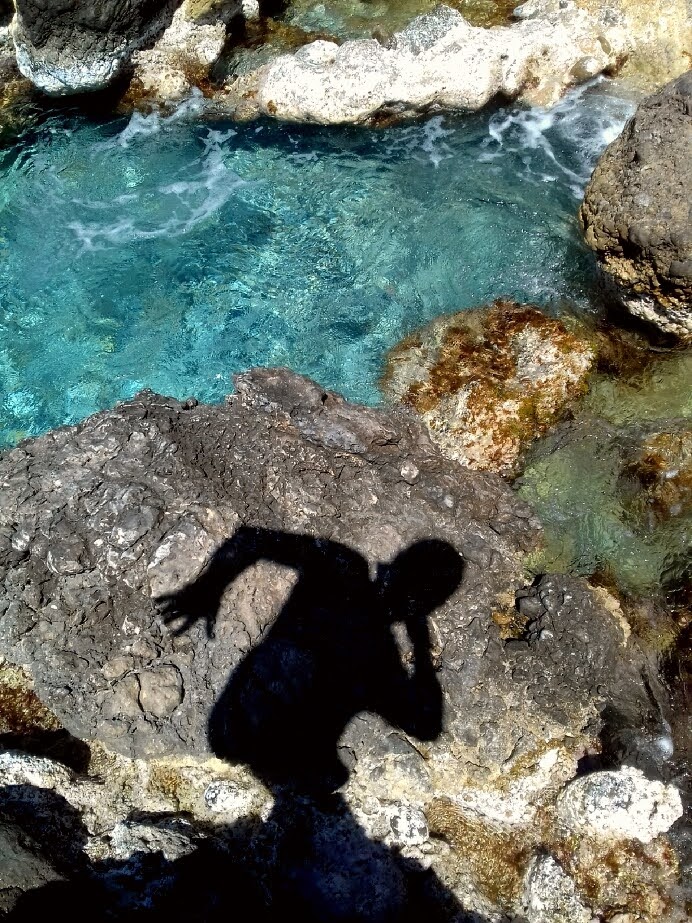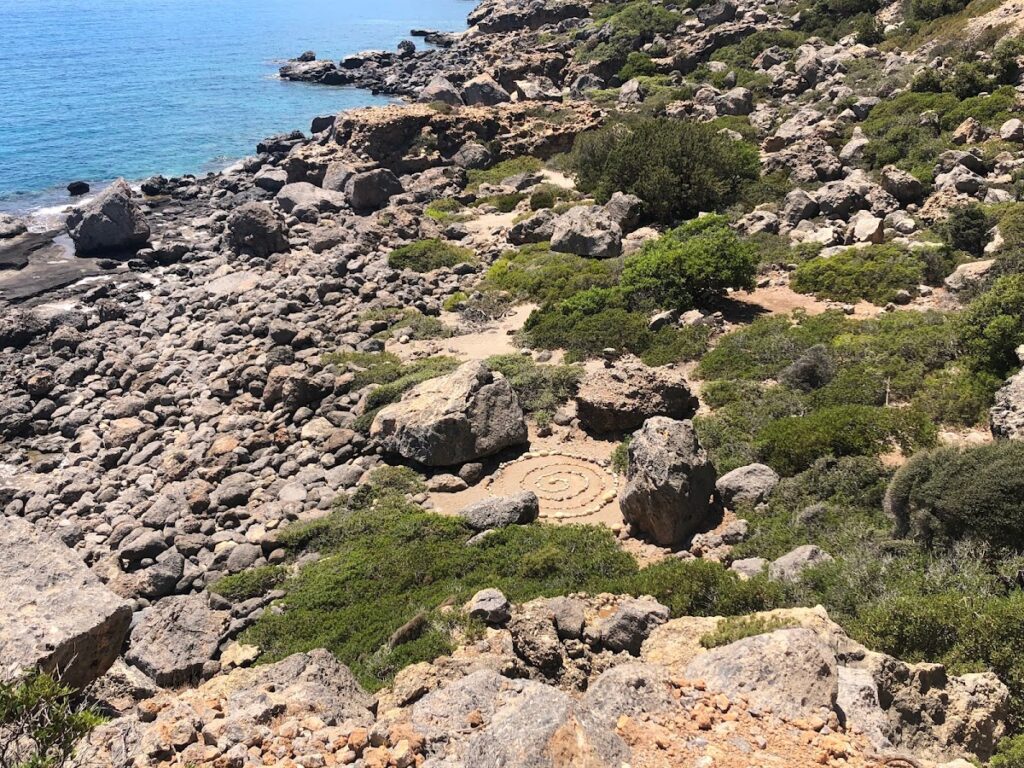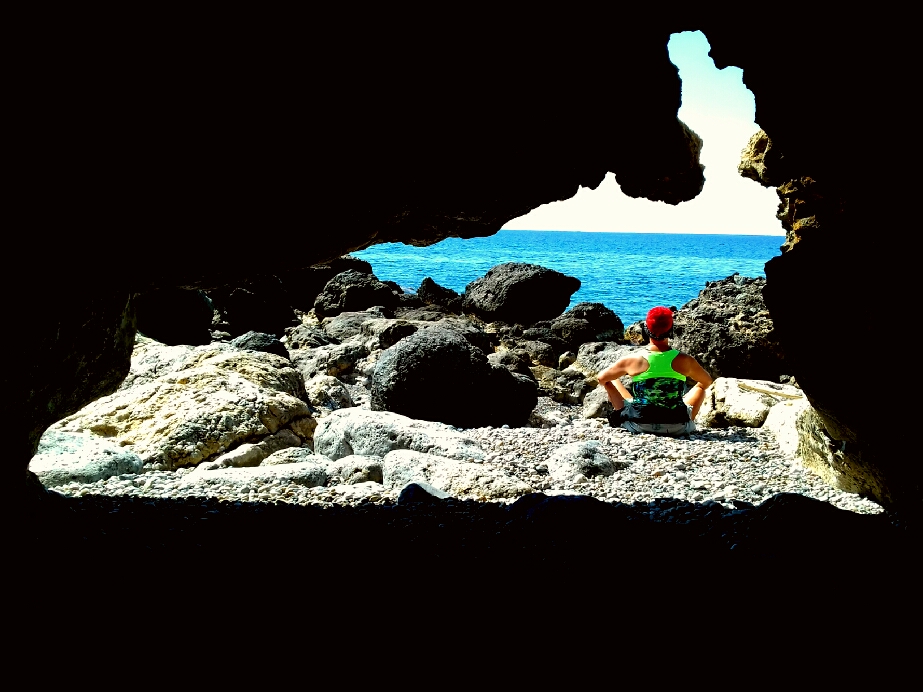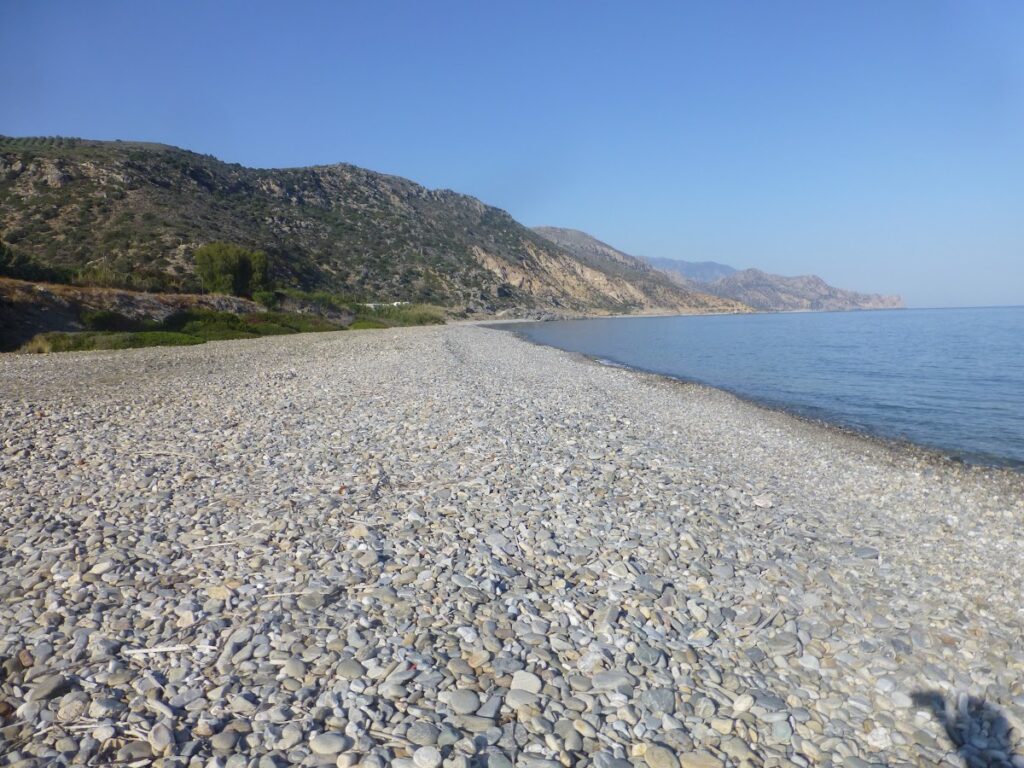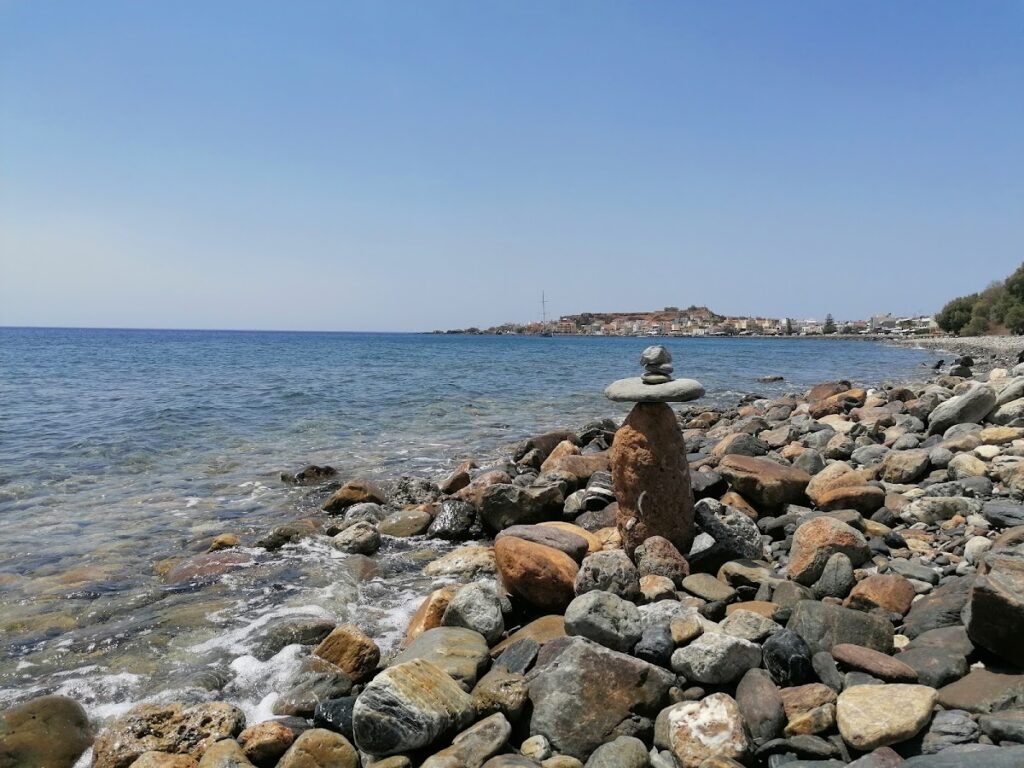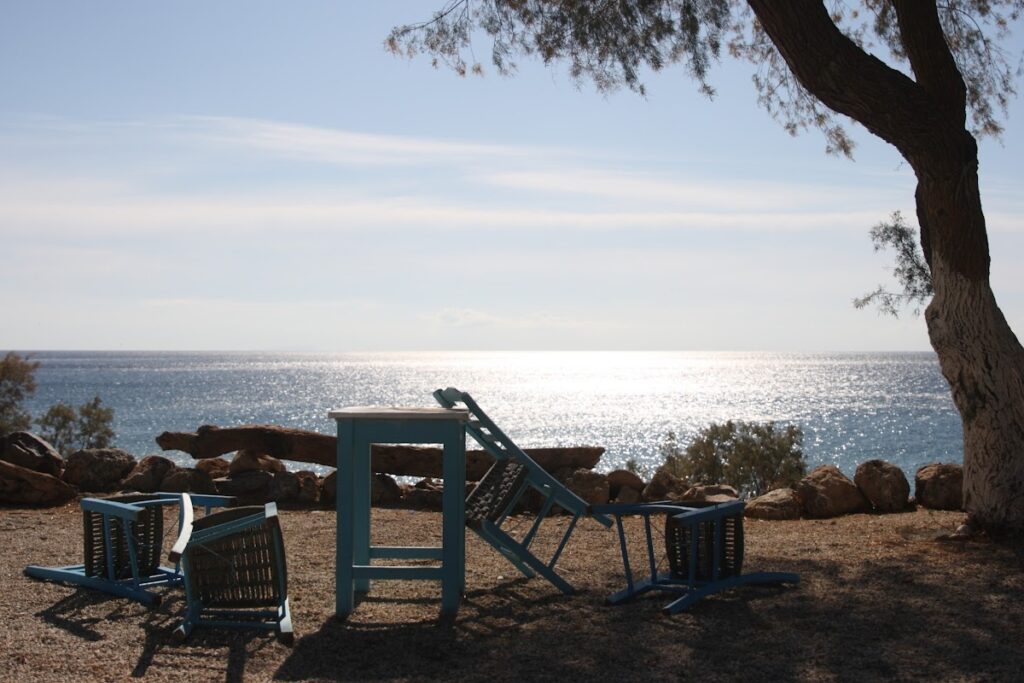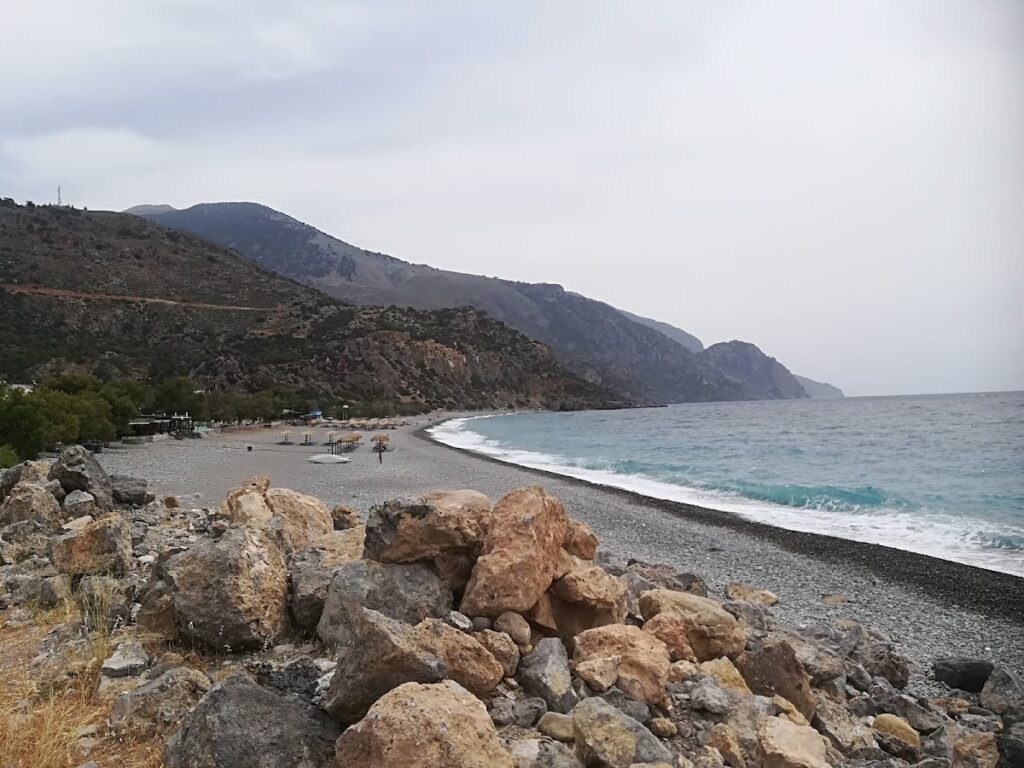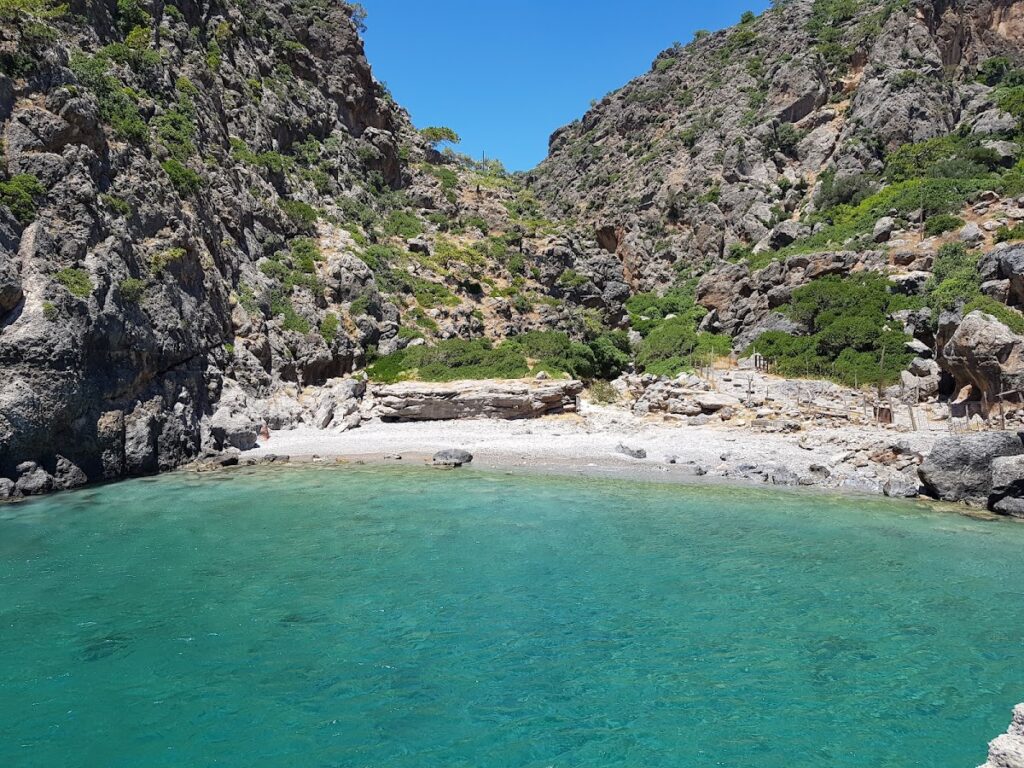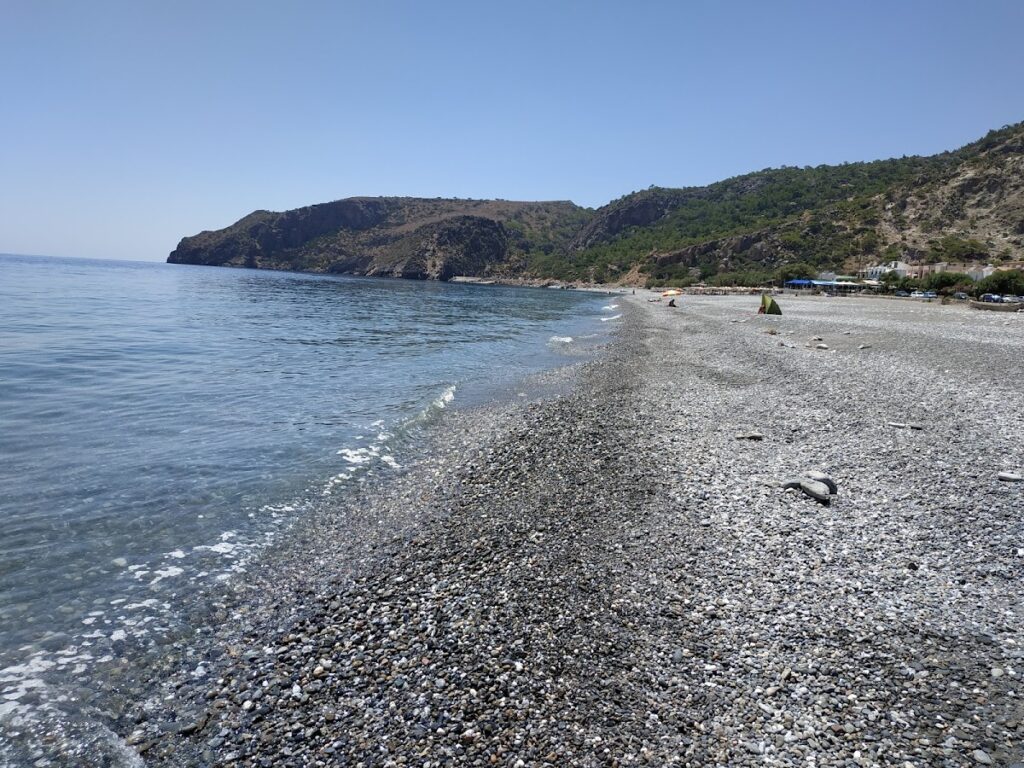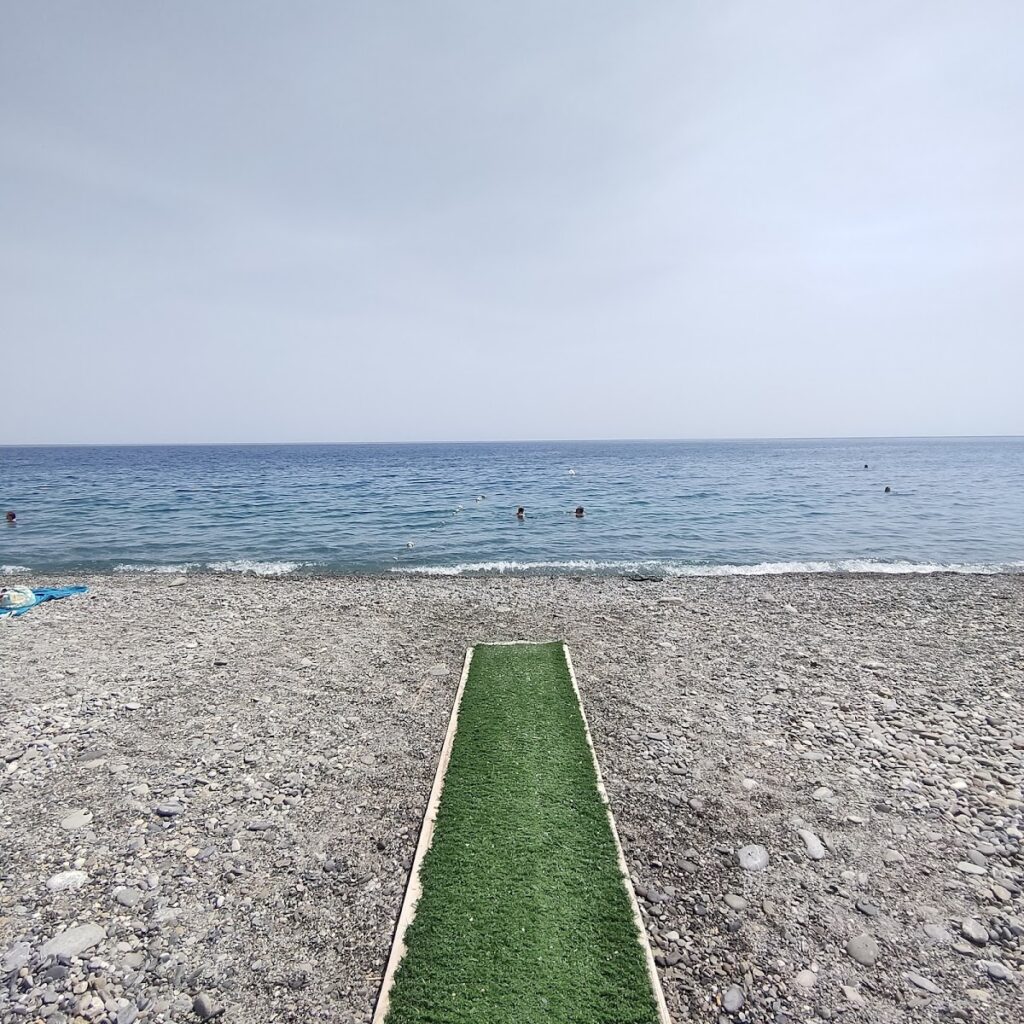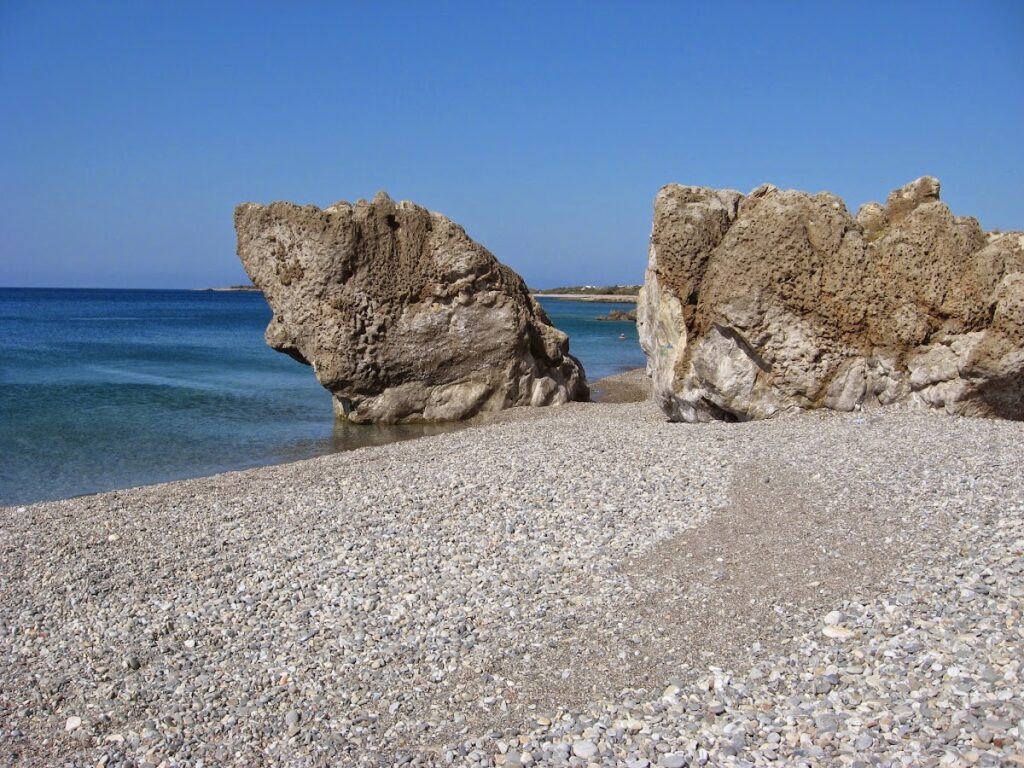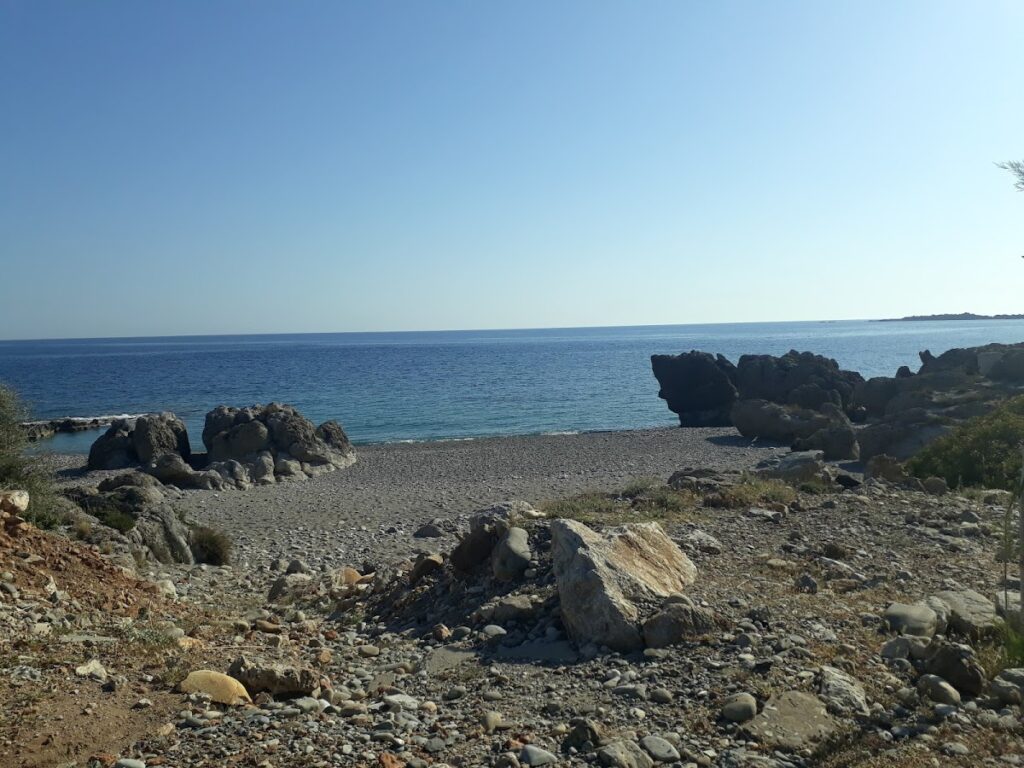Beaches near Asfendhilés, in Chania region
Here is list of closest beaches to Asfendhilés
- 3.3 km
- Astropelekita beach
- Fine Pebbles, Sand
- Normal
- Blue
On the European E4 trail linking Sougia and Paleochora, you’ll come across the stunning small beach of Astropelekita with its deep blue waters. This sandy beach, situated to the east of the rocky Plaka cape, is encountered before beginning the ascent to Flomes or Elide Cape, on the way to the ancient Lissos. This little cove offers a perfect opportunity for a refreshing swim while trekking the E4 trail.
Astropelekita, translating to ‘thunderbolt’ in Greek, is named after a local myth. The tale suggests that the area’s distinctive whitish rocks were created when the Olympian Gods hurled a thunderbolt at the region.

- 5.6 km
- Lissos beach
- Pebbles
- Normal
- Blue
Lissos Beach, situated in the Agios Kyrikos region, lies about 71km south of Chania city and 3km west of Sougia. It was historically the seaport for the nearby town of Elyros, the remnants of which can now be found near the modern village of Rodovani.
Lissos Beach is a secluded and unspoiled spot, characterized by large pebbles and exposure to the southern winds. Visitors and campers can find shade under the beach’s abundant trees. Access to the beach is either via a 20-minute boat ride or a 90 to 120-minute hike from Sougia, a journey that passes through the scattered ruins of ancient Lissos.
Near the beach stands the charming Church of St. Kirikos, which holds a celebration on July 15th. If you happen to be in the area the day before, you can join in the festivities. Pilgrims arrive by boat from Sougia to participate in the ceremony and subsequent celebration.
Lissos experienced its golden age during the Hellenistic period, flourishing until the 9th century when it was razed by the Saracens. The town was renowned for its asclepion, or healing thermal baths, which attracted patients from across the island. The mosaic floors of Asclepios, despite being damaged by an earthquake, are still visible today.
A walk through the Lissos Valley will reveal an array of ancient ruins, including capitals, a Roman cemetery with vaulted graves, and the remains of an ancient theatre. The discovery of numerous statues and coins in the region suggests that Lissos was more prosperous than its parent city, Elyros. The most notable statues, those of the Goddess Hygeia (Health), Asclepius, and Pluto, are now displayed in the Archaeological Museum in Chania.

- 5.7 km
- Keratides beach
- Pebbles
- Normal
- Blue
Keratides beach, situated approximately 1km west of Paleochora harbour and 79km south of Chania city, is found just past the Azogirianos river and Halikia beach. Characterized by its coarse pebbles and stones, it’s a preferred spot for those seeking tranquility and solitude. Its name, Keratides, is derived from the term for locust or carob trees, ‘keratia’. Nearby, there’s a camping site which attracts most of the beach’s visitors.
While there are numerous remarkable beaches in the vicinity of Paleochora, Keratides doesn’t particularly stand out. Nonetheless, it’s a viable option for those without access to a car or motorbike.
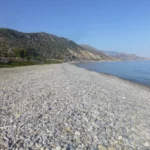
- 6.1 km
- Halikia beach
- Pebbles
- Normal
- Blue
Votsala or Halikia beaches are situated just beyond the western limit of Paleochora harbour, about 79km to the south of Chania city, adjacent to the Kakodiakianos River’s outlet and stretch approximately 1km eastward. Halikia and Pahia Ammos are the primary beaches in the town of Paleohora. Halikia, with its round pebbles, is well maintained and is primarily favored by Greeks over the sandy Pahia Ammos beach. This beach is a popular choice for those who wish to stay near the town and enjoy easy access to all facilities.
Following the Azogirianos River’s exit, the subsequent beach named Keratides beach is formed. This beach is conveniently located next to the Paleochora camping site.

- 6.7 km
- Pahia Ammos beach, Paleohora
- Sand
- Shallow
- Blue
Pahia Ammos (translating to Thick Sand) beach is situated on the western flank of Paleochora, a distance of 79km to the south of the city of Chania. It serves as the primary beach of Paleochora, offering an array of amenities for tourists and is meticulously maintained. Despite its impressive length of nearly 500m, it often appears unoccupied due to its expansive size. With its gentle sandy shore and shallow waters, it’s an ideal spot for children. However, caution is advised during periods of westerly or southerly winds, as they cause substantial waves.
A variety of services are available, including umbrellas, bars, snack bars, water sports gear, showers, and a lifeguard tower. The beach’s western area offers privacy and is frequently chosen by nudists.

- 7.2 km
- Sougia beach
- Fine Pebbles
- Deep
- Blue
Sougia is a charming village situated at the entrance of the beautiful Agia Irini Gorge, 75km west of Chania city. Once a 70’s hippie haven, it now serves as a peaceful getaway offering relaxing vacations amidst scenic landscapes, equipped with necessary amenities. The village features a variety of restaurants, taverns, accommodation choices, cafes, bars, and mini markets, though larger facilities like gas stations, hospitals, pharmacies or banks are not available in this secluded paradise.
The village is home to a beautiful, long beach adorned with pebbly sand and crystal-clear deep water. The beach stretches an impressive 1.5km from the quaint harbour of Sougia at the Lissos Gorge exit to the east, concluding in a private cove surrounded by rocks. This part of the beach, largely undeveloped, is a favourite among naturists. The beach section facing the village, however, is well-equipped with facilities including umbrellas, showers, sports facilities, and a lifeguard tower. Tamarisk trees dotted along the beach provide ample shade.
In the summer, daily ferries carry tourists from Sougia to various destinations such as Chora Sfakion, Paleochora, Agia Roumeli, Gavdos Island, and Loutro.
Historical Importance and Nearby Attractions to Sougia
Known as Syia (“place of hogs” in Greek) in ancient times, Sougia was once a hub for pig herding due to the region’s abundant oak trees. Today, you can still see the oak trees while trekking through the majestic Agia Irini Gorge, a popular tourist spot in West Crete.
Consider exploring the remains of the Doric town of Elyros, with Syia acting as its port in the past. The ruins are located on Kefala hill, near Rodovani village. Elyros flourished from 500 to 350 BC, being one of the main cities of southwest Crete with approximately 16,000 inhabitants. Known for its weapons manufacturing, Elyros even had its own currency.
Other points of interest include the Church of Saint Panteleimon, built on the site of Syia’s early Christian Basilica, which houses ancient mosaics depicting natural scenes from the 6th century AD. Although the church is usually closed, keys can be obtained at the local kiosk.
Near Sougia, the archaeological site of Lissos, Elyros’ secondary seaport, contains remnants of an ancient theatre, thermal baths, and the Asclepeion, fed by the Lissos spring. Accessible by a boat or a hike through the Lissos Gorge, the ruined city is a two-hour walk away.
Lastly, a two-hour hike east on the E4 trail towards Agia Roumeli will take you to the picturesque St. Anthony Chapel, situated in a scenic cove, and further on, the legendary cave of Polyphemus.
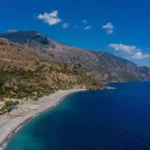
- 8.5 km
- Karavopetra coves, Paleohora
- Fine Pebbles, Pebbles
- Normal
- Blue
The Paleochora Coves are a chain of miniature bays that commence 1.5 km west of Paleochora and stretch 2.5 km westward to Cape Grammenos. These beaches are a complex of adjacent coves with crystal clear waters and magnificent pebbles. The main road, which links Paleochora and Koundoura, is situated alongside the coves, making them less popular with nudists.
Kalamia is the first beach you encounter 700m west of Paleohora, named after the reeds that inhabit the area (Kalamia translates to reeds). The next bay on the east side, 1.5 km west of Paleochora, is Psilos Volakas (Tall Rock), named after a large rock that shields the beach from southern winds. With its lovely small pebbles and lack of natural shade, the rocky seabed behind the large rock is perfect for snorkelling.
Continuing 200m westward from the beach, you’ll discover the secluded cove of Trohalou, a more rugged version of Psilos Volakas with larger pebbles and stones (Trohalou translates to “stony beach”). Although it’s never crowded, it’s one of the best snorkelling spots in the broader Paleochora area.
300m west of Trochalou lies the charming beach of Karavopetra (Ship-Stone in Greek), noted for its large rock that resembles a boat in the center of the beach. Apart from the main beach, a separate little cove can be found on Karavopetra’s western edge. Open to the southern winds, Karavopetra’s coarse sand and pebbles make it an excellent choice for bathing.
Next to Karavopetra, you’ll find Plakaki, a small cove shielded by a short rocky peninsula. This unorganized beach with pebbles is a wonderful spot. With rooms and restaurants nearby, Plakaki is a great option for those not wishing to head back to Paleochora. The beautiful beaches of Grammenos start directly west of Plakaki.
Choosing among these splendid beaches can be challenging, as each one offers something unique. We suggest driving down the road that runs along the shore to see which cove catches your eye!

- 9.9 km
- Grammeno beaches, Paleohora
- Pebbles, Sand
- Normal, Shallow
- Blue
The Grammeno peninsula is situated at the mouth of the Pelekaniotis river, 85km southward from Chania and 5km to the east of Paleochora. It lies on the route that links Paleochora with Koundoura. The beautiful Alonaki, Votsalo or Gialos beach with its fine and coarse pebbles as well as its crystalline sea stretches from the eastern part of the peninsula, extending eastwards. The unprotected 500m-long beach is prone to waves, with umbrellas provided on its western part for shade, while the eastern part is more serene.
On the western side of the peninsula, you’ll find the stunning Chouma bay. This sandy cove is well-sheltered and faces west. The Grammeno peninsula is home to a significant colony of protected junipers. While these trees provide shade, they are incredibly fragile and hence should be treated with care. It’s strictly forbidden to break branches, given their slow growth rate of only 1cm per year. Visitors are encouraged to use the umbrellas provided on the beach and avoid any contact with the trees.
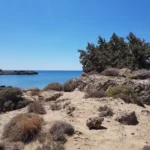
- 11.1 km
- Koundoura beach
- Sand
- Normal
- Blue
Agia Kyriaki beach, also known as Koundoura, is situated 88km south of Chania, 7km west of Paleochora, and a mere 0.5km west of Grammeno peninsula. The beach gets its alternate name from its location in the Koundoura region. The area’s warm climate is ideal for the growth of greenhouse crops.
The relatively secluded Koundoura beach stretches for 700 meters. Despite its proximity to the greenhouses, it’s not a common spot for swimming due to its obscurity. However, it’s an excellent choice for those seeking solitude. While there are no amenities on the beach itself, Grammeno offers several restaurants, a camping site, and a few accommodations.
Access to the beach is possible by car. From Paleochora, drive west towards Krios until you reach Grammenos peninsula. After about half a kilometer, turn left on the road leading to the sea.
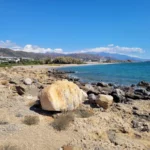
- 12.9 km
- Tripiti beach - Sfakia
- Fine Pebbles, Rocks in places
- Deep
- Blue
The rocky beach of Tripiti is located 5km east of Sougia and 68km south of Chania city, at the ending point of the wild gorge of Trypiti. It is absolutely secluded, like all the beaches of the wider Sfakia area. Access to Tripiti is possible either by boat or by walking on a difficult path from Sougia (three hours). The vertical cliffs near the beach provide natural shade. If you walk 500m east to the beach, you’ll meet the much nicer pebbly beach of Sendoni, used by beekeepers.
Tripiti is believed to be the site of the ancient town Pikilasos with the protected natural harbour. The port has been converted to a reef with incredible formations after some geological changes during the 4th AD century. Inscriptions have been discovered in the area, revealing the existence of a temple dedicated to Serapis (Greco-Egyptian god of antiquity). Moreover, archaeologists have discovered several tombs, carved in the rocks.
On the beach, there is a cistern with water, a goat pen and the picturesque church of Agios Nikolaos. If you are in the area on July 19, you can take part in the celebration of the Prophet Elijah, which celebrates on July 20. The pilgrims arrive by boat in the afternoon on the beach of Trypiti and then walk on the path leading to the chapel of Prophet Elijah, 400 meters above sea level. They spend the night there with food and traditional Cretan songs and leave the next day. On the peak of the same hill, there are the ruins of Fort Voukelasi.
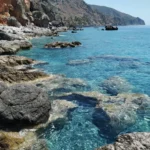
No results available
ResetBeaches in other nearby areas
No results available
Reset